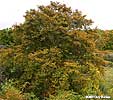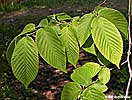
Trees of Wisconsin
The leaves of Ostrya virginiana are simple, alternate and doubly-toothed. The fruit looks somewhat like the fruit of Hops (Humulus lupulus), hence the common name "hop-hornbeam". The name Ironwood refers to the great strength of the wood which was highly prized for tool handles etc. It is smaller than many other trees and usually does not reach the canopy. The bark of mature Ostrya trees tends to split into narrow vertical strips and becomes somewhat flaky and the appearance is very distinctive. It is common for the trees to hold some of the dead leaves on the branches throughout winter. Mature trees of Ostry virginiana are easily distinguished from our other trees, but in seedling and sapling stages the leaves and winter buds are similar to Betula alleghaniensis in general appearance and can be difficult to distinguish. Immature leaves early in the summer may also be mistaken for Corylus cornuta which may grow as non-flowering plants in the understory of mesic forests with Ostrya. The bud scales of Ostrya are more likely to have conspicuous longitudinal ridges (striations) than those of Betula alleghaniensis. Petioles of Ostrya leaves tend to be shorter than 1 cm at maturity and the petioles of Betula alleghaniensis are mostly longer than 1 cm. The fruits are also very different, but are not necessary to identify mature trees and are not present on young plants. B. alleghaniensis branches (except the youngest twigs and the fastest growing sprouts) tend to produce at least some (and usually all) leaves on short spur branches which support two leaves close together. Ostrya does not normally produce spur branches, the leaves therefore always borne singly. Ostrya virginiana is present over much of the eastern U.S. from Minnesota to Texas and east to Florida and Maine. It is found throughout Wisconsin in upland deciduous forests. |
|









